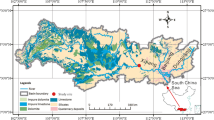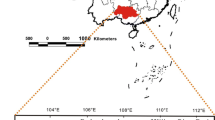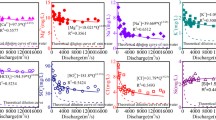Abstract
Monthly hydrogeochemical and discharge values were collected in the middle and upper reaches of the Xijiang River basin from April 2011 to March 2012 for the purpose of assessing the impact of anthropogenic activities on geological carbon sinks. The results of this study show that (1) the main ions in river water were influenced by different natural conditions and anthropogenic activities; (2) in a hydrological year, weathering fluxes of dissolved inorganic carbon (DIC) were 50.00 × 108, 1.52 × 108, and 1.79 × 108 kg CO2 in the Wuzhou, Zhaoping, and Yangshuo transects, respectively; and furthermore, DICcarbonate acid (carbon flux caused by carbonic acid) were 37.71 × 108, 1.31 × 108, and 1.56 × 108 kg CO2, respectively, which represents approximately 31.56, 10.15, and 15.29 g CO2 m−2 in the monitoring period; (3) the carbon flux from the participation of allogenic acid (such as sulfuric acid or nitric acid) in carbonate rock weathering was obvious, which must be eliminated from the calculation of the net carbon sink in carbonate rock weathering because it would be released into the atmosphere as a carbon source; and (4) in the geological processes, there was a clearly carbon sink loss caused by anthropogenic activities in various ways, which is attributed to the addition of nitric acid and sulfuric acid, such as through agricultural and industrial activities, and hydropower stations.



Similar content being viewed by others
References
Amiotte SP, Probst A, Probst JL (1995) Influence of acid rain on CO2 consumption by rock weathering: local and global scales Water, Air and Soil Pollution, vol 85. Kluwer Academic Publishers, Netherlands, pp 1563–1568
Anne SP, Anne P, Jean LP (2008) Impact of nitrogenous fertilizers on carbonate dissolution in small agricultural catchments: implications for weathering CO2 uptake at regional and global scales. Geochim Cosmochim Acta 72:3105–3123
Bonnet MP, PouLin M, Devaux J (2000) Numerical modeling of thermal stratification in a lake reservoir. Methodology and case study. Aquat Sci 62(2):105–124
Brusca L, Aiuppa AD, Alessandro W, Parello F, Allard P, Michel A (2001) Geochemical mapping of magmatic gas–water–rock interactions in the aquifer of Mount Etna volcano. J Volcanol Geotherm Res 108(1–4):199–218
Cao J, Yang H, Kang Z (2011) Preliminary regional estimation of carbon sink flux by carbonate rock corrosion: a case study of the Pearl River Basin. Chin Sci Bull 56(35):3766–3773
Cassar N, Laws EA, Bidigare RR, Popp BN (2004) Bicarbonate uptake by southern ocean phytoplankton. Global Biogeochemical Cycles 18: 1–10 GB2003. doi:10.1029/2003GB002116
Chen JS, He DW (1999) Chemical characteristics and genesis of major ions in the Pearl River Basin. Acta Scientiarum Naturalium Universitatis Pekinensis 35(6):786–793 (in Chinese)
Dean WE, Gorham E (1998) Magnitude and significance of carbon burial in lakes, reservoirs, and peatlands. Geology 26:535–538
Ding H, Lang YC, Liu CQ, Liu TZ (2013) Chemical characteristics and δ34 S-SO4 2− of acid rain: anthropogenic sulfate deposition and its impacts on CO2 consumption in the rural karst area of southwest China. Geochem J 47(6):625–638
Dupré B, Dessert C (2003) Rivers, chemical weathering and Earth’s climate. Comptes Rendus Geosci 335(16):1141–1160
Gaillardet J, Dupré B, Allègre CJ (1997) Chemical and physical denudation in the Amazon River Basin. Chem Geol 142(3):141–173
Galy A, France-Lanord C (2001) Higher erosion rates in the Himalaya: geochemical constraints on riverine fluxes. Geology 29(1):23–26
Gao QZ, Shen CD, Sun YM (2001) Chemical weathering in Zhujiang River catchment. Geochimica 30(3):223–230 (in Chinese)
Gao QZ, Tao Z, Huang X, Nan L, Yu K, Wang Z (2009) Chemical weathering and CO2 consumption in the Xijiang River basin, South China. Geomorphology 106:324–332
Gassama N, Cocirta C, Kasper HU (2012) Use of major and selected trace elements to describe mixing processes in a water reservoir. CR Geosci 344(1):25–32
Gibbs RJ (1972) Water chemistry of the Amazon River. Geochim Cosmochim Acta 36(9):1061–1066
He SY (1996) Field study methods in karst geochemistry and some examples. Carsologica Sin 15(1–2):200–206 (in Chinese)
Huang QB, Liu PY, Qin XQ (2011) The characteristics of karst carbon sink in the Guijiang catchment. Carsologica Sin 30(4):437–442 (in Chinese)
Joshua WA, Galy A, Bickle M (2005) Tectonic and climatic controls on silicate weathering. Earth Planet Sci Lett 235(1):211–228
Lerman A, Wu L (2006) CO2 and sulfuric acid controls of weathering and river water composition. J Geochem Explor 88:427–430
Lerman A, Wu L, Mackerzie FT (2007) CO2 and H2SO4 consumption in weathering and material transport to the ocean, and their role in the global carbon balance. Mar Chem 6:326–350
Li SL, Calmels D, Han GL, Gaillardet J, Liu CQ (2008) Sulfuric acid as an agent of carbonate weathering constrained by δ13C-DIC: Examples from Southwest China. Earth Planet Sci Lett 270(3):189–199
Liu ZH (1990) Necessities of measuring pH in site in the study of karst hydrogeochemistry. Carsologica Sin 9(4):310–317 (in Chinese)
Liu ZH (2012) Recent advance and prospect of carbon sink caused by rock weathering. Chin Sci Bull 57(2–3):95–102 (in Chinese)
Liu CQ, Jiang YK, Tao FX (2008) Chemical weathering of carbonate rocks by sulfuric acid and the carbon cycling in Southwest China. Geochimica 04:404–414 (in Chinese)
Liu ZH, Dreybrodt W, Liu H (2011) Atmospheric CO2 sink: silicate weathering or carbonate weathering? Quat Sci 31:426–430 (in Chinese)
Maier-Peimer E (1993) The biological pump in the greenhouse. Glob Planet Change 8(1):13–15
Melnikov NB, O’Neill BC (2006) Learning about the carbon cycle from global budget data. Geophys Res Lett 33: L02705(1–4). doi:10.1029/2005GL023935
Négrel P, Roy S (1998) Chemistry of rainwater in the Massif Central (France): a strontium isotope and major element study. Appl Geochem 13(8):941–952
Perrin AS, Probst A, Probst JL (2008) Impact of nitrogenous fertilizers on carbonate dissolution in small agricultural catchments: Implications for weathering CO2 uptake at regional and global scales. Geochim Cosmochim Acta 72(3):3105–3123
Qin XQ, Liu PY, Huang QB (2013) Estimation of atmospheric/soil CO2 consumption by rock weathering in the Pearl River valley. Acta Geosci Sin 34(4):455–462 (in Chinese)
Rattan L (2008) Carbon sequestration. Philos Trans R Soc B Biol Sci 363:815–830. doi:10.1098/rstb.2007.2185
Semhi K, Amiotte SP, Clauer N (2000) Impact of nitrogen fertilizers on the natural weathering-erosion processes and fluvial transport in the Garonne basin. Appl Geochem 15(6):865–874
Seulgi M, Youngsook H, Jian HQ, Nguyen VP (2007) Chemical weathering in the Hong (Red) River basin: rates of silicate weathering and their controlling factors. Geochim Cosmochim Acta 71:1411–1430
Sun H, Han J, Zhang S, Lu X (2015) Carbon isotopic evidence for transformation of DIC to POC in the lower Xijiang River, SE China. Quaternary International
Sundquist ET (1993) The global carbon dioxide budget. Science 259:934–941
The pearl river compilation committee (1991) The pearl river. Guangdong science and technology publishing house, Guang Zhou, p 150 (in Chinese)
Wang H, Zhang CL, Yang H (2011) The application of stable carbon isotope to the study of carbon sources in Guijiang watershed, Guangxi. Acta Geosci Sin 32(6):691–698 (in Chinese)
Wang S, Qian X, Han BP, Luo LC, Hamilton DP (2012) Effects of local climate and hydrological conditions on the thermal regime of reservoir at Tropic of Cancer in southern China. Water Res 46(8):2591–2604
Watson RT, MeriaFilho LG, Sanhueza E (1992) The Supplementary Report to the IPCC scientific assessment (in climate change). Cambridge Press, Cambridge, pp 29–46
Yao GR, Gao QZ, Wang ZG (2008) Seasonal and spatial variations of dissolved inorganic carbon in the lower reaches of the Xijiang River and its export flux. Geochimica 37(3):258–264 (in Chinese)
Yu S, He SY, Yang H (2012) Research on carbon source effect of acid rain in a typical carbonate rock area, Guangxi. Earth Environ 40(1):44–49 (in Chinese)
Yu S, Du WY, Sun PA (2014) Study on the hydrochemistry character and carbon sink in the middle and upper reaches of the Xijiang River basin. Environ Earth Sci, China. doi:10.1007/s12665-014-3771-y
Yue L (1995) Geochemical mass balances of major chemical constituents in the watershed of the Changhuajian River in China. Aquat Geochem 1:147–156
Zhang C (2011) Time-scale of karst processes and the carbon sink stability. Carsologica Sin 30(4):368–371 (in Chinese)
Zhang XB, Jiang YJ, Qiu SL (2012) Agricultural activities and carbon cycling in karst areas in southwest China: dissolving carbonate rocks and CO2 sink. Adv Earth Sci 27(4):466–476 (in Chinese)
Acknowledgments
This work was supported by the National Natural Science Foundation of China (41402324, 41402238 and 41572234), the Project of the China Geological Survey (12120113005100, 121201107000150003), the Project of Natural Science Foundation of Guangxi (2014GXNSFBA118228), the open foundation of Karst Dynamics Laboratory (14-A-04-02) and Project of Institute of karst Geology, CAGS (201429).
Author information
Authors and Affiliations
Corresponding authors
Rights and permissions
About this article
Cite this article
Yu, S., He, S., Sun, P. et al. Impacts of anthropogenic activities on weathering and carbon fluxes: a case study in the Xijiang River basin, southwest China. Environ Earth Sci 75, 589 (2016). https://doi.org/10.1007/s12665-015-5226-5
Received:
Accepted:
Published:
DOI: https://doi.org/10.1007/s12665-015-5226-5




